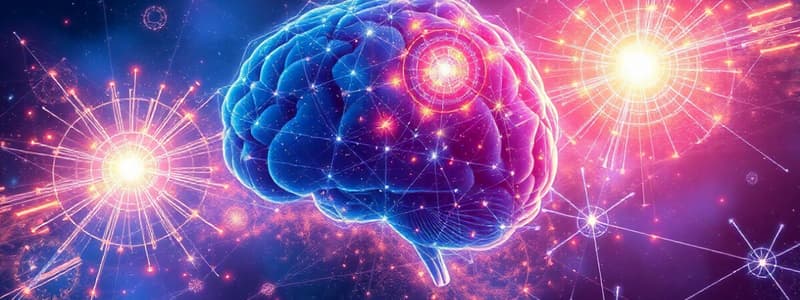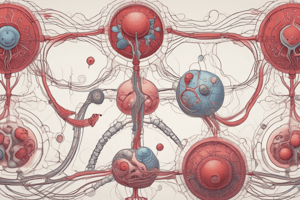Podcast
Questions and Answers
How does the spider Cyclosa octotuberculata leverage its environment to enhance its predatory capabilities?
How does the spider Cyclosa octotuberculata leverage its environment to enhance its predatory capabilities?
- By altering the tension of specific silk threads in its web based on recent prey detection. (correct)
- By camouflaging itself to match the colors of its surroundings.
- By remembering the exact locations of past successful prey captures.
- By emitting a scent that attracts prey to specific locations in its web.
What is 'extended cognition' as it relates to mathematics, according to the passage?
What is 'extended cognition' as it relates to mathematics, according to the passage?
- The use of mathematical models to predict future events.
- The collaboration between mathematicians to solve complex problems.
- The outsourcing of intellectual processes to the environment, such as writing equations. (correct)
- The ability to perform complex calculations mentally without external aids.
How does the formalism of mathematics contribute to scientific honesty, as suggested in the passage?
How does the formalism of mathematics contribute to scientific honesty, as suggested in the passage?
- By providing a universal language that all scientists can understand.
- By exposing assumptions and ambiguities that might otherwise remain hidden. (correct)
- By eliminating the need for interpretation in scientific communication.
- By making calculations easier to verify.
What is a primary reason why biology has been slower to embrace mathematics compared to fields like physics?
What is a primary reason why biology has been slower to embrace mathematics compared to fields like physics?
What is the key advantage of using mathematical models, rather than simple stories, to understand biological systems?
What is the key advantage of using mathematical models, rather than simple stories, to understand biological systems?
What is the critical balance that mathematicians must maintain when creating equations to model the real world?
What is the critical balance that mathematicians must maintain when creating equations to model the real world?
What is the significance of self-consistency in mathematical models, according to the passage?
What is the significance of self-consistency in mathematical models, according to the passage?
Why is mathematical modeling considered essential for understanding the brain?
Why is mathematical modeling considered essential for understanding the brain?
What practical application did Leyden jars have beyond scientific study in the mid-eighteenth century?
What practical application did Leyden jars have beyond scientific study in the mid-eighteenth century?
How did Luigi Galvani's experiments contribute to the understanding of electricity's role in animal function?
How did Luigi Galvani's experiments contribute to the understanding of electricity's role in animal function?
What was Alessandro Volta's primary criticism of Galvani's theory of 'animal electricity'?
What was Alessandro Volta's primary criticism of Galvani's theory of 'animal electricity'?
Why did Emil du Bois-Reymond need to coil more than a mile of wire by hand for his experiments?
Why did Emil du Bois-Reymond need to coil more than a mile of wire by hand for his experiments?
What key contribution did Julius Bernstein make to the study of nervous electricity?
What key contribution did Julius Bernstein make to the study of nervous electricity?
What term describes the characteristic pattern of changes in the electrical properties of a cell?
What term describes the characteristic pattern of changes in the electrical properties of a cell?
What is Ohm's law, and why was it initially met with resistance from Ohm's peers?
What is Ohm's law, and why was it initially met with resistance from Ohm's peers?
What key electrical components did Louis Lapicque use to describe the nerve in terms of an 'equivalent circuit'?
What key electrical components did Louis Lapicque use to describe the nerve in terms of an 'equivalent circuit'?
How did Hodgkin and Huxley expand the role of resistance in neural electrical activity?
How did Hodgkin and Huxley expand the role of resistance in neural electrical activity?
How are Hodgkin and Huxley's artificial action potentials achieved, once injected with a current
How are Hodgkin and Huxley's artificial action potentials achieved, once injected with a current
What is the main insight demonstrated of the Hodgkin and Huxley model?
What is the main insight demonstrated of the Hodgkin and Huxley model?
What did the article say about Eccles's beliefs around dendrites?
What did the article say about Eccles's beliefs around dendrites?
In 1943, what did the paper 'A logical calculus of the ideas immanent in nercous activity' find?
In 1943, what did the paper 'A logical calculus of the ideas immanent in nercous activity' find?
In Rosenblatt's view, one of the important differences between the McCulloch-Pitts network and the Perceptron was what?
In Rosenblatt's view, one of the important differences between the McCulloch-Pitts network and the Perceptron was what?
Flashcards
Extended Cognition
Extended Cognition
The outsourcing of intellect to the environment.
Goal of Mathematics
Goal of Mathematics
Mathematics eliminates the need for intelligent thought.
Lotka-Volterra Model
Lotka-Volterra Model
A model consisting of two equations describing the growth of prey and predator populations.
Capacitor
Capacitor
Signup and view all the flashcards
Voltage
Voltage
Signup and view all the flashcards
Ohm's Law
Ohm's Law
Signup and view all the flashcards
Resistance
Resistance
Signup and view all the flashcards
Action potential
Action potential
Signup and view all the flashcards
Equivalent Circuit
Equivalent Circuit
Signup and view all the flashcards
All-or-Nothing Principle
All-or-Nothing Principle
Signup and view all the flashcards
Leaky Integrate-and-Fire Neuron
Leaky Integrate-and-Fire Neuron
Signup and view all the flashcards
Spike
Spike
Signup and view all the flashcards
Dendrites
Dendrites
Signup and view all the flashcards
Cable Theory
Cable Theory
Signup and view all the flashcards
McCulloch-Pitts Model
McCulloch-Pitts Model
Signup and view all the flashcards
Artificial neural networks
Artificial neural networks
Signup and view all the flashcards
Perceptron
Perceptron
Signup and view all the flashcards
Learning
Learning
Signup and view all the flashcards
Connectionism
Connectionism
Signup and view all the flashcards
Study Notes
Introduction
- The book "Models of the Mind" is dedicated to the author's father.
- It was first published in the UK in 2021 by Bloomsbury Publishing Plc under the Bloomsbury Sigma imprint.
- Copyright is held by Grace Lindsay in 2021 and illustrations are by Julian Baker.
Spherical Cows: The Essence of Mathematics
- The spider Cyclosa octotuberculata inhabits Japan and builds webs that incorporate information about prey locations.
- Alterations to the web offload cognition to the environment, a concept known as 'extended cognition'.
- Mathematics is described as a form of extended cognition.
- Writing equations expands mental capacity, leaving a trail of thought for oneself and others.
- Cognitive scientists believe reliance on extended cognition is due to the limitations of brains.
- Mathematics is a language that can "do real work" and provides a systematic way to export thinking to paper or machines.
- Mathematics serves to eliminate the need for intelligent thought according to Alfred Whitehead.
- Physics has developed an ethos of rigorous quantitative thinking, as mathematics is precise enough to describe the world. Assumptions are laid bare and ambiguities have nowhere to hide.
- Equations capture specific information and mathematics ties together disparate topics.
- Mathematics is the language of the natural world that is precise enough for scientific application.
Biology's Slow Embrace of Math
- Biology, including brain study, has been slower to embrace mathematics than other fields.
- Some biologists are skeptical of mathematics due to its perceived complexity and simplicity.
- Biologists find mathematics complex because of unfamiliar abstract details.
- Biologist Yuri Lazebnik suggests biologists believe calculus problems can be solved with arithmetic with enough tries.
- Mathematics is considered too simple to capture the complexity of biological phenomena.
- Physicists jest about the simplifications that mathematical approaches require, such as assuming a spherical cow in a vacuum for analysis.
- Simplifying a problem opens it up to mathematical analysis, so inevitable biological details get lost in translation from the real world to equations.
- Ramon y Cajal wrote about theorists avoiding reality, and mathematicians squash real world abundance when equations are created.
- Oversimplification and aesthetic obsession are pitfalls of applying math to the real world, but biology needs math because of its inherent richness and complexity.
- Example: considering rabbit and fox populations mathematically determines their outcomes, using the Lotka-Volterra model.
- The Lotka-Volterra model consists of two equations describing prey and predator population growth.
- Dynamical systems theory is used to describe interactions of bodies and these tell if the animals survive.
- Using math enhances the understanding of biology and without math we are sadly limited.
- Reducing biology to variables and equations requires creativity, expertise, and discernment.
- Each model component must be defined precisely and exactly.
- Mathematical models describe theories about biological systems precisely to communicate them.
- Good models can predict future experiments and synthesize past results; models are virtual labs to "perform" not yet feasible physical experiments.
- Digital models help scientists define important functional parts of a system.
- Integral work of the above nature could hardly be accomplished without math.
- Equations force precise and self-consistent models, to allow implications to be worked out.
- Mathematical formulation forces model self-consistency, and while it doesn't necessarily mean truth, self-inconsistency surely is falsehood.
- The brain is too complex to be understood without math.
- Mathematical modeling at multiple levels allows for understanding of how it can be accomplished by single complex cells.
- Theoretical or computational neuroscience is a fully developed part
- The mathematical mindset influences the study of the brain.
- Life science students must be solid in mathematics and CS, those who do not feel guilty about it.
- "All models are wrong" because they ignore some details.
- Charles Darwin regretted not understanding the great principles of math.
- Mathematical ideas and explanations are provided, but models solve different problems and offer approaches to understanding.
- Topics cover the physics from single cells up to the behaviors.
How Neurons Get Their Spike
- Johannes Müller stated in his 1840 textbook that the laws of action of the nervous principle are different than electricity, and widely read his book.
- Müller who was a professor at Humboldt University of Berlin and believed in the vital organizing force of the Lebenskraft, stated the nature of activity in the nerves is not electric and may be imponderable and incapable.
- Müller was wrong, and the animation of nerves would prove the movement of charged particles and that electricity is the ink in which the code is written.
- Bio-electricity gives opportunity, and by creating a path the tools could be applied, equations could share symbols and wires and circuits could be captured.
- The nervous depended on the study of electricity.
- Leyden jars, named after a Dutch town, store electric charge.
- Devices developed in the mid-18th century, marked a turning point in the study of electricity and they transmit electricity and were able to cause nosebleeds or unconsciousness.
- A Leyden jar is now called a capacitor.
- Charge disparity creates voltage and as more charge is added voltage increases.
- The potential energy turns into kinetics as particles move to their counterparts and this voltage is a shock.
- Luigi Galvani (born in 1737) was an Italian scientist studied surgery and anatomy.
- Galvani used electrostatic machines and Leyden jars and focused on frogs in medical experiments.
- After death frog muscles can still work and is desirable.
- Lucia (probably someone) touched a metal scalpel to a frogs nerve at an exact moment creating charge and Galvani expanded upon that.
- Galvani describes the animal electricity as a force intrinsic to animals as fluid.
- Ibn Rushd, a 12th-century Muslim philosopher, saw that electric fish have electricity similar to lodestone.
- Physicians were already exploring electricity as a cure to paralysis before Galvani.
- Galvani's set of experiments took the animal electricity part way, and he gathered evidence that animal movement follows from electricity.
- Galvanis' electric animation made its way in to Mary Shelly writing, Frankenstein.
- All of the academic peers of Galvani was so enthusiastically accepting of his claims.
Studying That Suits You
Use AI to generate personalized quizzes and flashcards to suit your learning preferences.




